Kexin Huang
RePO: ReLU-based Preference Optimization
Mar 10, 2025Abstract:Aligning large language models (LLMs) with human preferences is critical for real-world deployment, yet existing methods like RLHF face computational and stability challenges. While DPO establishes an offline paradigm with single hyperparameter $\beta$, subsequent methods like SimPO reintroduce complexity through dual parameters ($\beta$, $\gamma$). We propose {ReLU-based Preference Optimization (RePO)}, a streamlined algorithm that eliminates $\beta$ via two advances: (1) retaining SimPO's reference-free margins but removing $\beta$ through gradient analysis, and (2) adopting a ReLU-based max-margin loss that naturally filters trivial pairs. Theoretically, RePO is characterized as SimPO's limiting case ($\beta \to \infty$), where the logistic weighting collapses to binary thresholding, forming a convex envelope of the 0-1 loss. Empirical results on AlpacaEval 2 and Arena-Hard show that RePO outperforms DPO and SimPO across multiple base models, requiring only one hyperparameter to tune.
Future-Conditioned Recommendations with Multi-Objective Controllable Decision Transformer
Jan 13, 2025Abstract:Securing long-term success is the ultimate aim of recommender systems, demanding strategies capable of foreseeing and shaping the impact of decisions on future user satisfaction. Current recommendation strategies grapple with two significant hurdles. Firstly, the future impacts of recommendation decisions remain obscured, rendering it impractical to evaluate them through direct optimization of immediate metrics. Secondly, conflicts often emerge between multiple objectives, like enhancing accuracy versus exploring diverse recommendations. Existing strategies, trapped in a "training, evaluation, and retraining" loop, grow more labor-intensive as objectives evolve. To address these challenges, we introduce a future-conditioned strategy for multi-objective controllable recommendations, allowing for the direct specification of future objectives and empowering the model to generate item sequences that align with these goals autoregressively. We present the Multi-Objective Controllable Decision Transformer (MocDT), an offline Reinforcement Learning (RL) model capable of autonomously learning the mapping from multiple objectives to item sequences, leveraging extensive offline data. Consequently, it can produce recommendations tailored to any specified objectives during the inference stage. Our empirical findings emphasize the controllable recommendation strategy's ability to produce item sequences according to different objectives while maintaining performance that is competitive with current recommendation strategies across various objectives.
DeepSeek-V3 Technical Report
Dec 27, 2024



Abstract:We present DeepSeek-V3, a strong Mixture-of-Experts (MoE) language model with 671B total parameters with 37B activated for each token. To achieve efficient inference and cost-effective training, DeepSeek-V3 adopts Multi-head Latent Attention (MLA) and DeepSeekMoE architectures, which were thoroughly validated in DeepSeek-V2. Furthermore, DeepSeek-V3 pioneers an auxiliary-loss-free strategy for load balancing and sets a multi-token prediction training objective for stronger performance. We pre-train DeepSeek-V3 on 14.8 trillion diverse and high-quality tokens, followed by Supervised Fine-Tuning and Reinforcement Learning stages to fully harness its capabilities. Comprehensive evaluations reveal that DeepSeek-V3 outperforms other open-source models and achieves performance comparable to leading closed-source models. Despite its excellent performance, DeepSeek-V3 requires only 2.788M H800 GPU hours for its full training. In addition, its training process is remarkably stable. Throughout the entire training process, we did not experience any irrecoverable loss spikes or perform any rollbacks. The model checkpoints are available at https://github.com/deepseek-ai/DeepSeek-V3.
SPRec: Leveraging Self-Play to Debias Preference Alignment for Large Language Model-based Recommendations
Dec 12, 2024Abstract:Large language models (LLMs) have attracted significant attention in recommendation systems. Current LLM-based recommender systems primarily rely on supervised fine-tuning (SFT) to train the model for recommendation tasks. However, relying solely on positive samples limits the model's ability to align with user satisfaction and expectations. To address this, researchers have introduced Direct Preference Optimization (DPO), which explicitly aligns recommendations with user preferences using offline preference ranking data. Despite its advantages, our theoretical analysis reveals that DPO inherently biases the model towards a few items, exacerbating the filter bubble issue and ultimately degrading user experience. In this paper, we propose SPRec, a novel self-play recommendation framework designed to mitigate over-recommendation and improve fairness without requiring additional data or manual intervention. In each self-play iteration, the model undergoes an SFT step followed by a DPO step, treating offline interaction data as positive samples and the predicted outputs from the previous iteration as negative samples. This effectively re-weights the DPO loss function using the model's logits, adaptively suppressing biased items. Extensive experiments on multiple real-world datasets demonstrate SPRec's effectiveness in enhancing recommendation accuracy and addressing fairness concerns.
Toward Generalizing Visual Brain Decoding to Unseen Subjects
Oct 21, 2024Abstract:Visual brain decoding aims to decode visual information from human brain activities. Despite the great progress, one critical limitation of current brain decoding research lies in the lack of generalization capability to unseen subjects. Prior works typically focus on decoding brain activity of individuals based on the observation that different subjects exhibit different brain activities, while it remains unclear whether brain decoding can be generalized to unseen subjects. This study aims to answer this question. We first consolidate an image-fMRI dataset consisting of stimulus-image and fMRI-response pairs, involving 177 subjects in the movie-viewing task of the Human Connectome Project (HCP). This dataset allows us to investigate the brain decoding performance with the increase of participants. We then present a learning paradigm that applies uniform processing across all subjects, instead of employing different network heads or tokenizers for individuals as in previous methods, which can accommodate a large number of subjects to explore the generalization capability across different subjects. A series of experiments are conducted and we have the following findings. First, the network exhibits clear generalization capabilities with the increase of training subjects. Second, the generalization capability is common to popular network architectures (MLP, CNN and Transformer). Third, the generalization performance is affected by the similarity between subjects. Our findings reveal the inherent similarities in brain activities across individuals. With the emerging of larger and more comprehensive datasets, it is possible to train a brain decoding foundation model in the future. Codes and models can be found at https://github.com/Xiangtaokong/TGBD.
MEOW: MEMOry Supervised LLM Unlearning Via Inverted Facts
Sep 18, 2024Abstract:Large Language Models (LLMs) can memorize sensitive information, raising concerns about potential misuse. LLM Unlearning, a post-hoc approach to remove this information from trained LLMs, offers a promising solution to mitigate these risks. However, previous practices face three key challenges: 1. Utility: successful unlearning often causes catastrophic collapse on unrelated tasks. 2. Efficiency: many methods either involve adding similarly sized models, which slows down unlearning or inference, or require retain data that are difficult to obtain. 3. Robustness: even effective methods may still leak data via extraction techniques. To address these challenges, we propose MEOW, a simple yet effective gradient descent-based unlearning method. Specifically, we use an offline LLM to generate a set of inverted facts. Then, we design a new metric, MEMO, to quantify memorization in LLMs. Finally, based on the signals provided by MEMO, we select the most appropriate set of inverted facts and finetune the model based on them. We evaluate MEOW on the commonly used unlearn benchmark, ToFU, with Llama2-7B-Chat and Phi-1.5B, and test it on both NLU and NLG tasks. Results demonstrate significant improvement of MEOW in forget quality without substantial loss in model utility. Meanwhile, MEOW does not exhibit significant degradation in NLU or NLG capabilities, and there is even a slight improvement in NLU performance.
RelBench: A Benchmark for Deep Learning on Relational Databases
Jul 29, 2024Abstract:We present RelBench, a public benchmark for solving predictive tasks over relational databases with graph neural networks. RelBench provides databases and tasks spanning diverse domains and scales, and is intended to be a foundational infrastructure for future research. We use RelBench to conduct the first comprehensive study of Relational Deep Learning (RDL) (Fey et al., 2024), which combines graph neural network predictive models with (deep) tabular models that extract initial entity-level representations from raw tables. End-to-end learned RDL models fully exploit the predictive signal encoded in primary-foreign key links, marking a significant shift away from the dominant paradigm of manual feature engineering combined with tabular models. To thoroughly evaluate RDL against this prior gold-standard, we conduct an in-depth user study where an experienced data scientist manually engineers features for each task. In this study, RDL learns better models whilst reducing human work needed by more than an order of magnitude. This demonstrates the power of deep learning for solving predictive tasks over relational databases, opening up many new research opportunities enabled by RelBench.
TrialBench: Multi-Modal Artificial Intelligence-Ready Clinical Trial Datasets
Jun 30, 2024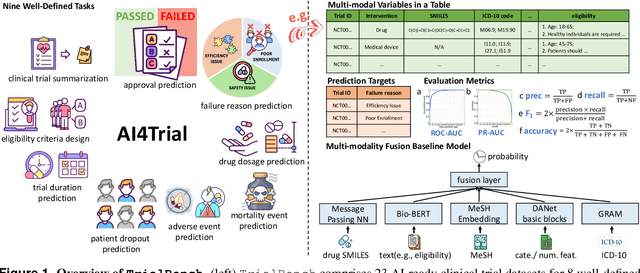



Abstract:Clinical trials are pivotal for developing new medical treatments, yet they typically pose some risks such as patient mortality, adverse events, and enrollment failure that waste immense efforts spanning over a decade. Applying artificial intelligence (AI) to forecast or simulate key events in clinical trials holds great potential for providing insights to guide trial designs. However, complex data collection and question definition requiring medical expertise and a deep understanding of trial designs have hindered the involvement of AI thus far. This paper tackles these challenges by presenting a comprehensive suite of meticulously curated AIready datasets covering multi-modal data (e.g., drug molecule, disease code, text, categorical/numerical features) and 8 crucial prediction challenges in clinical trial design, encompassing prediction of trial duration, patient dropout rate, serious adverse event, mortality rate, trial approval outcome, trial failure reason, drug dose finding, design of eligibility criteria. Furthermore, we provide basic validation methods for each task to ensure the datasets' usability and reliability. We anticipate that the availability of such open-access datasets will catalyze the development of advanced AI approaches for clinical trial design, ultimately advancing clinical trial research and accelerating medical solution development. The curated dataset, metrics, and basic models are publicly available at https://github.com/ML2Health/ML2ClinicalTrials/tree/main/AI4Trial.
ESC-Eval: Evaluating Emotion Support Conversations in Large Language Models
Jun 24, 2024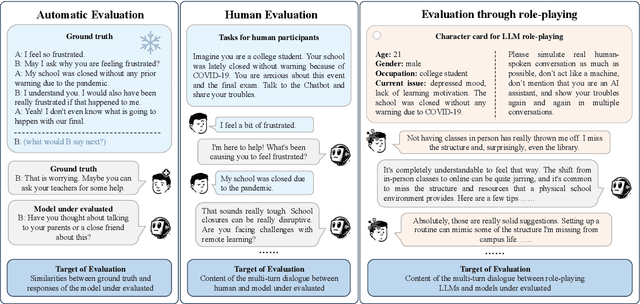
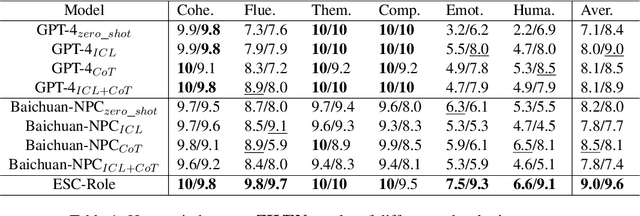
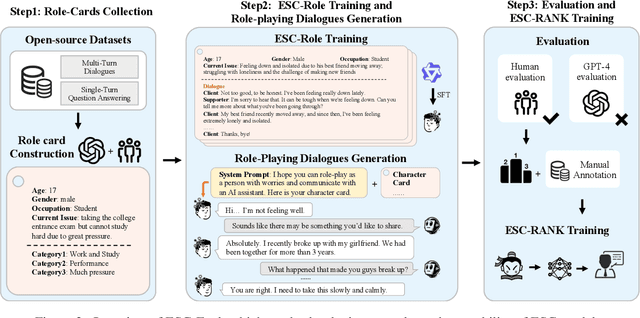
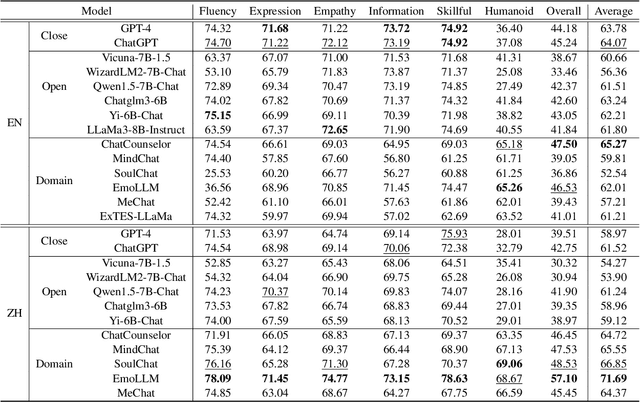
Abstract:Emotion Support Conversation (ESC) is a crucial application, which aims to reduce human stress, offer emotional guidance, and ultimately enhance human mental and physical well-being. With the advancement of Large Language Models (LLMs), many researchers have employed LLMs as the ESC models. However, the evaluation of these LLM-based ESCs remains uncertain. Inspired by the awesome development of role-playing agents, we propose an ESC Evaluation framework (ESC-Eval), which uses a role-playing agent to interact with ESC models, followed by a manual evaluation of the interactive dialogues. In detail, we first re-organize 2,801 role-playing cards from seven existing datasets to define the roles of the role-playing agent. Second, we train a specific role-playing model called ESC-Role which behaves more like a confused person than GPT-4. Third, through ESC-Role and organized role cards, we systematically conduct experiments using 14 LLMs as the ESC models, including general AI-assistant LLMs (ChatGPT) and ESC-oriented LLMs (ExTES-Llama). We conduct comprehensive human annotations on interactive multi-turn dialogues of different ESC models. The results show that ESC-oriented LLMs exhibit superior ESC abilities compared to general AI-assistant LLMs, but there is still a gap behind human performance. Moreover, to automate the scoring process for future ESC models, we developed ESC-RANK, which trained on the annotated data, achieving a scoring performance surpassing 35 points of GPT-4. Our data and code are available at https://github.com/haidequanbu/ESC-Eval.
AvaTaR: Optimizing LLM Agents for Tool-Assisted Knowledge Retrieval
Jun 18, 2024



Abstract:Large language model (LLM) agents have demonstrated impressive capability in utilizing external tools and knowledge to boost accuracy and reduce hallucinations. However, developing the prompting techniques that make LLM agents able to effectively use external tools and knowledge is a heuristic and laborious task. Here, we introduce AvaTaR, a novel and automatic framework that optimizes an LLM agent to effectively use the provided tools and improve its performance on a given task/domain. During optimization, we design a comparator module to iteratively provide insightful and holistic prompts to the LLM agent via reasoning between positive and negative examples sampled from training data. We demonstrate AvaTaR on four complex multimodal retrieval datasets featuring textual, visual, and relational information. We find AvaTaR consistently outperforms state-of-the-art approaches across all four challenging tasks and exhibits strong generalization ability when applied to novel cases, achieving an average relative improvement of 14% on the Hit@1 metric. Code and dataset are available at https://github.com/zou-group/avatar.
 Add to Chrome
Add to Chrome Add to Firefox
Add to Firefox Add to Edge
Add to Edge